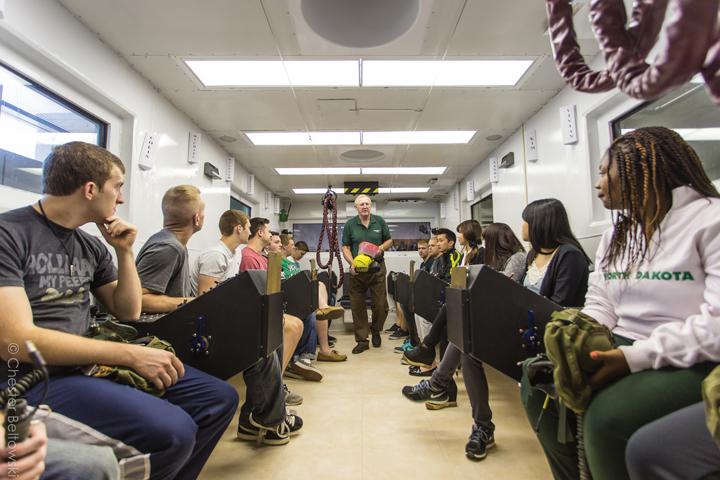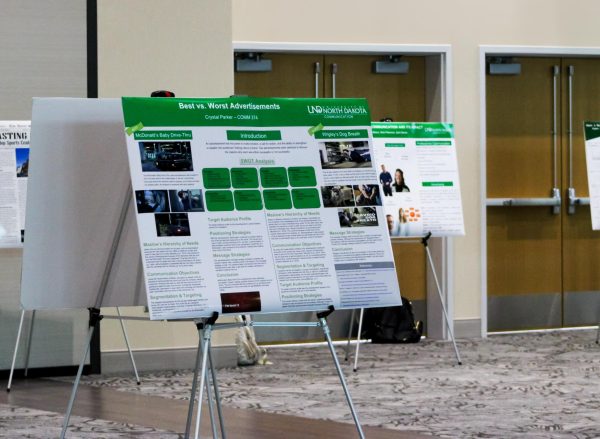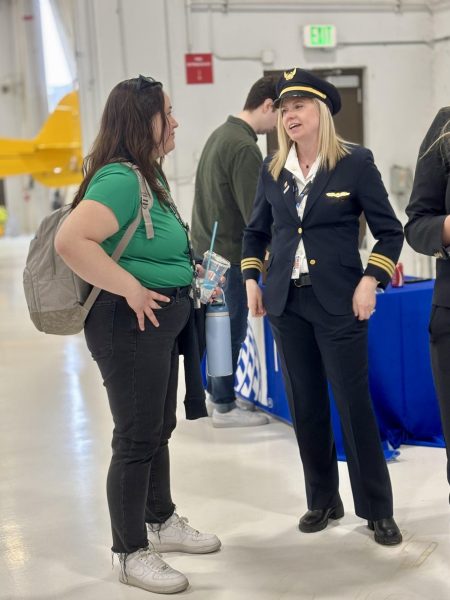Altitude chamber simulates hypoxia dangers
Aviation students learn the hard way what it’s like to suffer from oxygen deprivation
Students take a tour of the altitude chamber in Odegard Hall. They hold oxygen masks used in training exercises related to oxygen deprivation. Photo by Chester Beltowski/The Dakota Student.
UND’s altitude chamber in Odegard Hall provides aviation students with knowledge that could be the difference between life and death later in their careers.
Capable of simulating altitudes of 80,000 feet, the chamber is used to teach flight crews the physiological effects of high altitude in a safe environment.
It serves to simulate the feelings and sensations that accompany hypoxia, a condition that occurs when the body is deprived of oxygen.
“Generally, it starts out with people getting very vague symptoms, like headedness, dizziness, numbness and tingling,” Chester Fritz Distinguished Professor of Aviation and Flight surgeon Dr. Warren Jensen said. “Sometimes they get euphoria where they feel good. I’ve had students describe it as like having a couple of drinks.”
At 16,000 feet, the effects of hypoxia begin to kick in.
“At 25,000 feet most people have about three minutes before they become incapacitated,” Jenson said. “At 43,000 feet, we feel it’s roughly nine seconds until somebody is no longer able to care for themselves. So that’s why when decompressions occur at higher altitudes they have to do the right thing immediately.”
Students typically lose coordination and have difficulty thinking and processing as the room simulates high alltitudes. They are given worksheets during the simulation with basic math, penmanship and an easy maze. This allows them to see how much hypoxia affects their brain function as they are able to see their work when the simulation is over.
“Students from Japan, I’ll ask them to spell Japan backwards, and they can’t because that takes too much concentration,” Jensen said. “The American students I ask to spell their first name backwards, and after several minutes they can’t do it. And so we lose that capability, but we sometimes are unaware of it.”
The symptoms of hypoxia are different for each individual, which makes training together important for aviation students.
“There’s a value in training together so that you can understand what somebody else’s symptoms are because we will discuss the symptoms afterwards,” Jensen said. “That way if somebody starts complaining about a symptom you can be aware that it might be hypoxia, even if that’s not what your experience is.”
The altitude chamber is primarily used for training, but it also is used for research.
“Some of the research that we’ve done is looking at communication problems with people with mild hypoxia,” Jensen said. “So if we have people at 18,000 feet, we look to see how much communication they are missing — like for radio calls, how many errors do they make.”
UND received the chamber in 1989 from the Davis-Monthan Air Force Base. The base had it on surplus, destined to be recycled for steel. Instead, it was transported and refurbished to become a unique asset at UND Aerospace.
“Generally students do (look forward to the altitude simulations, but) some of them are a little nervous,” Jensen said. “It’s way outside of what they’ve done before. But once they’ve done it they see the value in it.”
Ashley Carlson is a staff writer for The Dakota Student. She can be reached at ashley.carlson@my.und.edu.










